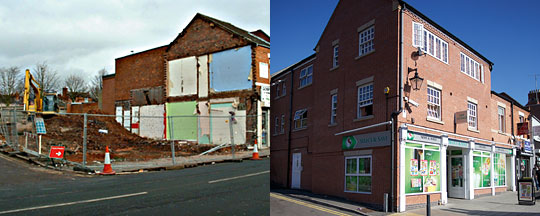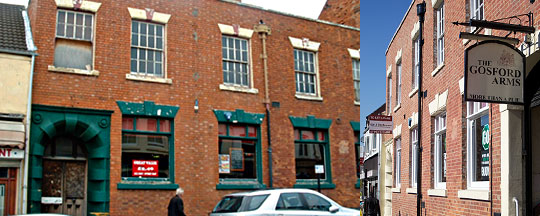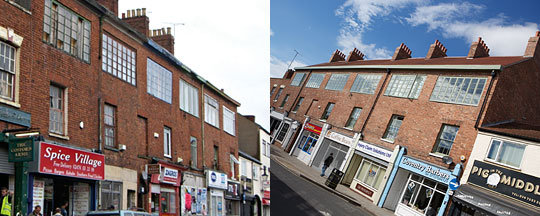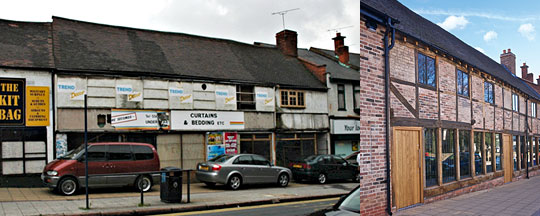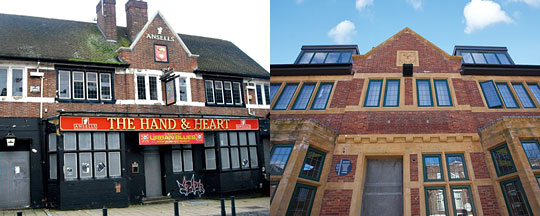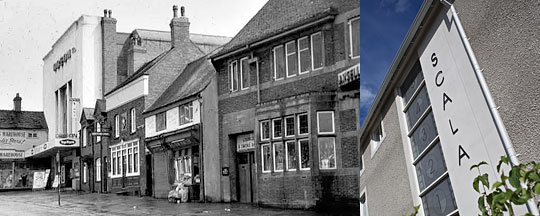Home » Today » Before & After
Thanks to funding support from the Heritage Lottery through its Townscape Heritage Initiative and European Regional Development Fund, huge progress has been made over the past 5 years to save important buildings, add sensitive new buildings on empty sites and improve the shop fronts on the street.
A selection of the improvements include:
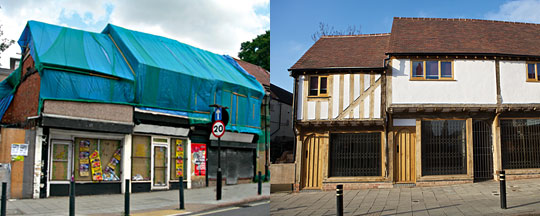
38–40 Far Gosford Street
This group of buildings dates from the 15th century but had partially collapsed and was a focus for drug users. The buildings have now been fully restored with support from Phase I Townscape Heritage Initiative.
No 38 was a double-bay structure forming a single house with 37, which was bombed in the war.
Nos 39-40 formed another double-bay single house, but was built at the same time and was integral with no 41.
41 Far Gosford Street
No 41 was originally connected to No 40 and the timber frame that survived continues through both buildings. The front was faced with brickwork to ‘modernise’ it in the Georgian period. Having suffered a fire, the building had partly collapsed and its survival was in doubt. Support from THI and ERDF has allowed a full restoration, retaining the medieval timberwork but also restoring the later Georgian elevation.
58 Far Gosford Street
No 58 is a two storey building with an odd monopitch roof with the gable end facing the street. It represents the surviving street-facing portion of what was originally a row of 14 Court dwellings known as Victoria Place and later Court No9. During restoration, large stone blocks were discovered in the boundary wall with No 59. It is likely that these came from the dismantled town wall and are from an earlier building on the site. The stone has been retained in situ.
The temporary building on the adjoining bomb site (59/60) has been demolished and a new building constructed as part of THI Phase 1.
The fine stained glass from the 1940’s denoting the shop as a Gents Outfitters will be reintroduced into the new building.
61–62 Far Gosford Street
Nos 61-62 were lost in 2003 just before the regeneration project commenced. The derelict buildings were so badly damaged by fire that they had to be demolished. The new buildings now on the site have been constructed in traditional ‘topshop’ style with large upper floor windows. The upper floors are used for housing. The proximity to the University means that much of the formerly empty upper floors in the street have been converted to student accommodation. The replacement building was supported by grant from THI Phase 1.
65–66 Far Gosford Street
For many years known as the Pitt’s Head Public House, the more recently renamed Gosford Arms was once used for stabling racehorses during the time that the Coventry races were held at nearby Stoke.
No 65 operated as an independent commercial premises until around 1920 after which it was absorbed as part of the adjoining public house at No 66. The building was hit by incendiary bombs in November 1940 and the audience in The Scala cinema opposite were drafted in to put out the flames. The original roof was never reconstructed and the unusual flat roof is a reminder to this day. The building was restored as part of the THI Phase 1 programme.
67–72 Far Gosford Street
The Topshops at 67-72 Far Gosford Street before and after restoration. These six listed buildings are rare survivors of what used to be a common building type in Coventry – ribbon weavers’ ‘top shops’. The three storey houses contained a weaving loom on the top floor, hence the large expanse of windows on the front and rear to provide light. The weaver’s family lived on the floors below. The ground floor to No. 68 has been restored back to the original house removing render and an aluminium window from the 1980’s.
The other five were turned into shops in the early 1900s and interesting tiled features have been retained in the restoration of the shopfronts. ‘Maypole’ and ‘Dewhurst’ provide continuing reminders of the high street names that used to line the street in its heyday.
The restoration of the rear of the properties has transformed the appearance of this part of the street from Sky Blue Way.
These heritage buildings have been changes from a blight on the city’s main approach, to an asset and a living example of the city’s history.
The Topshops were restored as part of the THI Phase 1 programme.
121–124 Far Gosford Street
This timber framed-building appears to date from the early 1600s, but its origins remain a mystery.
It does not follow any standard domestic form and may have begun its life as a barn. However, the timber that was used was not ‘green’, that is, from newly-felled timber, but re-used from other buildings, either on the site or from close by. There is evidence that the building continued down further the street.
This building has been fully restored with support from Advantage West Midlands. The restoration and reconstruction of the original timber frames required specialist traditional skills. Training of craftsmen ensured these skills were passed on to future generations. The building now is now the Regeneration Office.
Hand & Heart
A public house existed as the Hand and Heart on this site as far back as 1851 although not in the form of the current building which is an Arts and Crafts style pub built for Ansell’s in the inter-war years. During the 1970s and 80s, the Hand and Heart was a popular venue for local bands, when the city’s Ska music was leading the national scene. Bands of the 2 Tone genre such as The Specials and The Selecter were a popular draw and the Hand & Heart remains a loved icon of the days when Coventry led world music.
Scala Offices
The Scala Cinema was opened in 1912 and had an ornate Edwardian façade – a palace of silent film in the centre of the street. The cinema was refaced in the 1930’s and rebranded The Odeon in 1950, but remains known as The Scala (locally pronounced Scayler) to this day. The building was hit by bombs during the November blitz and five people lost their lives including a mother and boy of only 18 months. Yet the building survived to be turned into a bingo hall in 1963 and was only finally demolished in the 1970’s following a major fire.
The Scala was at the heart of the community and its memory has been preserved in the new Scala Offices built on the site. The design includes references to the Arts & Crafts movement and cinema iconography. These new offices provide quality employment opportunities for local people and an economic boost to trade in the street. A display is planned to tell the story of this important building and those that died – watching a film…


